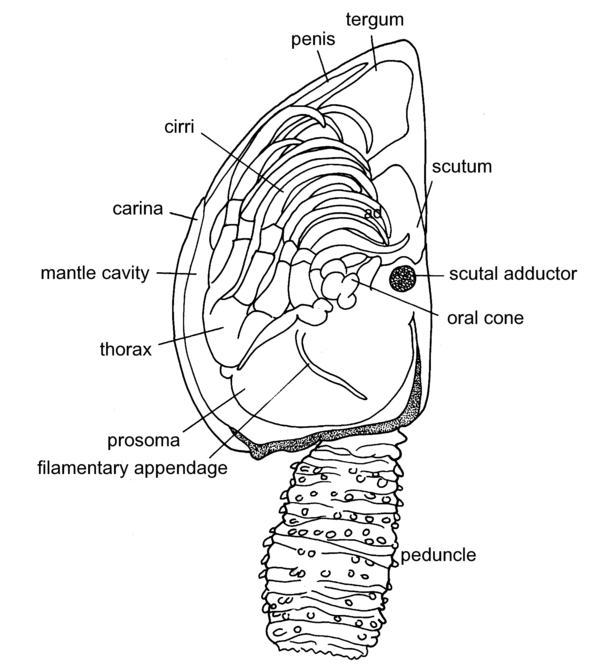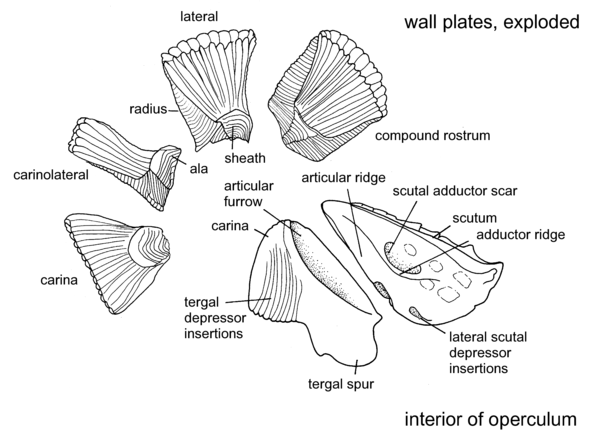- carina
- A raised ridge on the surface of the exoskeleton [Ingle, 1980].A ridge or keel of the exoskeleton (Fig. 1, 2). (Pl. carinae) [Perez Farfante and Kensley, 1997].Any keel-like structure, as on dorsum of pleon on some amphipods; in cirripeds, single compartment plate at end of shell where cirri are protruded, or adjacent to tergum, possessing alae only. See: carapace carina [Moore and McCormick, 1969].Any keellike structure; any well-defined projecting ridge on outer surface of carapace (podocopan Ostracoda); unpaired posterodorsal plate of thoracic Cirripedia (in lepadomorphs 1 of up to 4 unpaired plates of capitulum; in verrucomorphs compartmental plate between rostrum and fixed tergum; in balanomorphs compartmental plate, with alae on each side, opposite rostrum) [McLaughlin, 1980].Keel, acute ridge, crest [Poore, 2004].Keel, or ridge. (Pl. carinae) [Butler, T.H.].Keel-like ridge or prominence [Williams, 1984].Median middorsal ridge on rostrum; oriented parallel to lateral margins of rostrum (see Figs. 37,47) [Hobbs and Jass, 1988].(Order Notostraca):Median keel [Stachowitsch, 1992].(Order Decapoda):One of a number of narrow, elevated ridges along carapace or abdomen. According to position and according to group, those on carapace may be termed antennal, branchial, branchiocardiac, gastroorbital, lateral, orbital, posterior, postorbital, postrostral, rostral, subhepatic, submedian, and supraorbital carinae. (Syn. ridge, keel) [Stachowitsch, 1992].(Order Isopoda):A keel, or acute ridge [Wetzer et al. 1997].(Order Isopoda):A keel, or an acute ridge [Kensley and Schotte, 1989].(Order Stomatopoda):One in a series of longitudinal, keel-like elevations on dorsal surface of either carapace, thoracic somites (thoracomeres), abdominal somites (pleomeres) or telson. According to position (from midline outward) one may distinguish median, submedian, intermediate, lateral, marginal, and various accessory carinae or secondary ridges. Refers also to ventral elevations (e.g., postanal carina). (sharp, swollen/rounded; posteriorly spined, posteriorly rounded; straight, curved; median carina: bifurcate, not bifurcate) [Stachowitsch, 1992].(Subclass Cirripedia):(
 ) [Anderson, 1980].Lepas anatifera: left valve removed. [Anderson, 1980](Subclass Cirripedia):(
) [Anderson, 1980].Lepas anatifera: left valve removed. [Anderson, 1980](Subclass Cirripedia):( ) [Anderson, 1980].Balanus trigonus: apical view; left lateral view; and operculum, body, and branchiae. [Anderson, 1980](Subclass Cirripedia):(
) [Anderson, 1980].Balanus trigonus: apical view; left lateral view; and operculum, body, and branchiae. [Anderson, 1980](Subclass Cirripedia):( ) [Anderson, 1980].Balanus trigonus: wall plates, exploded; and interior of operculum. [Anderson, 1980](Subclass Cirripedia):One of five primary plates (carina, two scuta, two terga) on outer surface of barnacle: unpaired posterior plate. In stalked form, posterior plate on capitulum. In unstalked barnacle, compartmental plate between rostrum and fixed tergum (asymmetrical form) or plate opposite rostrum (symmetrical form); consists of median paries and lateral alae [Stachowitsch, 1992].(Class Ostracoda):Type of valve sculpture: prominent ridge or keel. (disconnected, excavate, ponticulate = perforate, simple, undercut; dorsal, marginal, median, ventral) [Stachowitsch, 1992].
) [Anderson, 1980].Balanus trigonus: wall plates, exploded; and interior of operculum. [Anderson, 1980](Subclass Cirripedia):One of five primary plates (carina, two scuta, two terga) on outer surface of barnacle: unpaired posterior plate. In stalked form, posterior plate on capitulum. In unstalked barnacle, compartmental plate between rostrum and fixed tergum (asymmetrical form) or plate opposite rostrum (symmetrical form); consists of median paries and lateral alae [Stachowitsch, 1992].(Class Ostracoda):Type of valve sculpture: prominent ridge or keel. (disconnected, excavate, ponticulate = perforate, simple, undercut; dorsal, marginal, median, ventral) [Stachowitsch, 1992].
Crustacea glossary. Natural History Museum of Los Angeles County. 2011.
